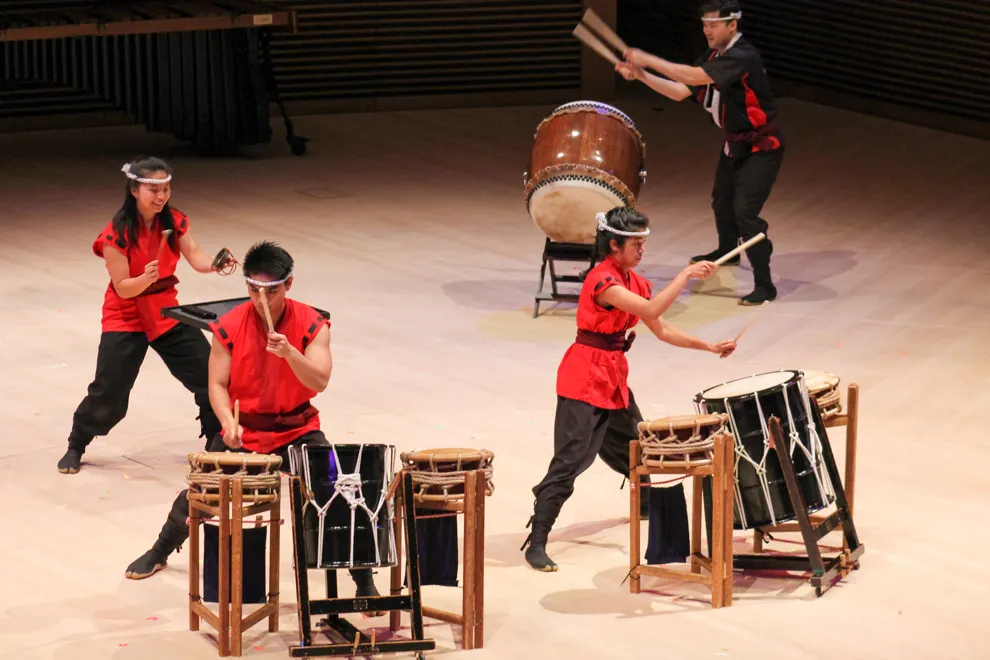
Linda Uyechi and Steve Sano, the faculty supervisors of Stanford Taiko, discuss all things taiko (Japanese/Japanese-American drumming) and how far the ensemble has come.
Part I: Linda and Steve introduce taiko (and dating tips!)
Linda welcomes me with a hug, and we walk into a serene, small courtyard in Braun Music Center teeming with bright green flora. It’s an apt location that encapsulates what I thought was a metaphor for Stanford Taiko itself – a place for deep introspection and relaxation, a bright albeit small community full of life and vibrant energy. Her husband Steve – the other key half of Stanford Taiko’s leading faculty – joins us shortly. Their playful banter and conversation bounce all over the place.
The Stanford Daily (TSD): What is taiko, and what does taiko mean to you?
Linda Uyechi (LU): Taiko is ensemble Japanese drumming. It’s a relatively new form, a new art form in Japan, because it started in the late ’50s, and in North America it was in the ’60s. So what does it mean to me? It means a lot to me … it has a lot to do with the Japanese-American community, it has a lot to do with Japanese-American identity. From my perspective, because when I started playing [in the early ’90s], that’s when I saw it and realized, it’s an incredibly powerful art form and it’s also empowering to play, especially for Asian-American women.
Steve Sano (SS): There’s always the response that taiko just means “drum.” But here in North America, I think in musical vernacular, it is the art form of taiko, and in that case, it means this art form of ensemble taiko, or kumi-daiko, which is how it is referred to here most often. So that is an ensemble staged performance. Staged doesn’t necessarily mean formally in a theater stage, but actually a choreographed, planned performance of art, as opposed to a festival or ritual.
Linda Uyechi is a former member of Stanford Taiko and San Jose Taiko. She trained under pioneers who spread North American taiko, including San Jose Taiko’s Artistic Director Emeritus P.J. Hirabayashi and Executive Director Emeritus Roy Hirabayashi. She currently serves as an instructor for the upcoming Introductory Seminar “Perspectives in North American Taiko,” a mentor for Stanford Taiko performers and a former board member of the Taiko Community Alliance (TCA), an organization that brings all North American taiko groups together.
Steve Sano, the co-advisor for Stanford Taiko, is also the director of the Choral Music Program, an instructor of the same IntroSem and the conductor of the Stanford Symphony Chorus. He oversees the logistical aspects of Stanford Taiko, including tours overseas. Both identify strongly with their Asian-American ties.
TSD: What initially drew you to taiko?
LU: I saw it; it looked powerful, it looked fun!
TSD: When did you first see it?
LU: That’s a good question. My first impression is that I saw it at an outdoor event, it was probably San Jose Taiko that I saw – I have no recollection of anything specific, but the one point I do remember seeing is the first time I saw Kodo at a concert here at MemAud. So that was – I forget what year that was – it was after 1985 … ’86, you know, late ’80s, so I saw Yoshikazu Yoshimoto in his fundoshi [traditional Japanese attire] playing odaiko [big drum]. And that was it. I was like, “I gotta do that!” But before that, truthfully, the answer is, before that I’d seen taiko in the Bay Area [I just don’t remember when].
TSD: What about you, Steve? What got you interested in taiko?
SS: Linda! [Laughter]
LU: Really!?
SS: Well, we were both grad students together and she was involved in it.
LU: Oh yeah!
SS: We just started dating. And it was like, you know that thing when you start dating, it’s like you get interested in what the person you’re dating does.
LU: Or you just lose them, right? [Laughter]
From the wide-eyed look I get when Linda talks about Kodo, an internationally renowned traditional taiko performing arts group, to the nostalgia behind talking about SJT, it becomes clear that taiko is not just a “drum.” To both Linda and Steve, drumming is a deeply personal and essential part of their lives.
Part two of this interview will be published later this week.
Stanford Taiko’s spring show will be held on Saturday, May 6 at 7:30 p.m. in Bing Concert Hall. Tickets are available online at live.stanford.edu.
Contact Maimi Higuchi at maimih ‘at’ stanford.edu.
